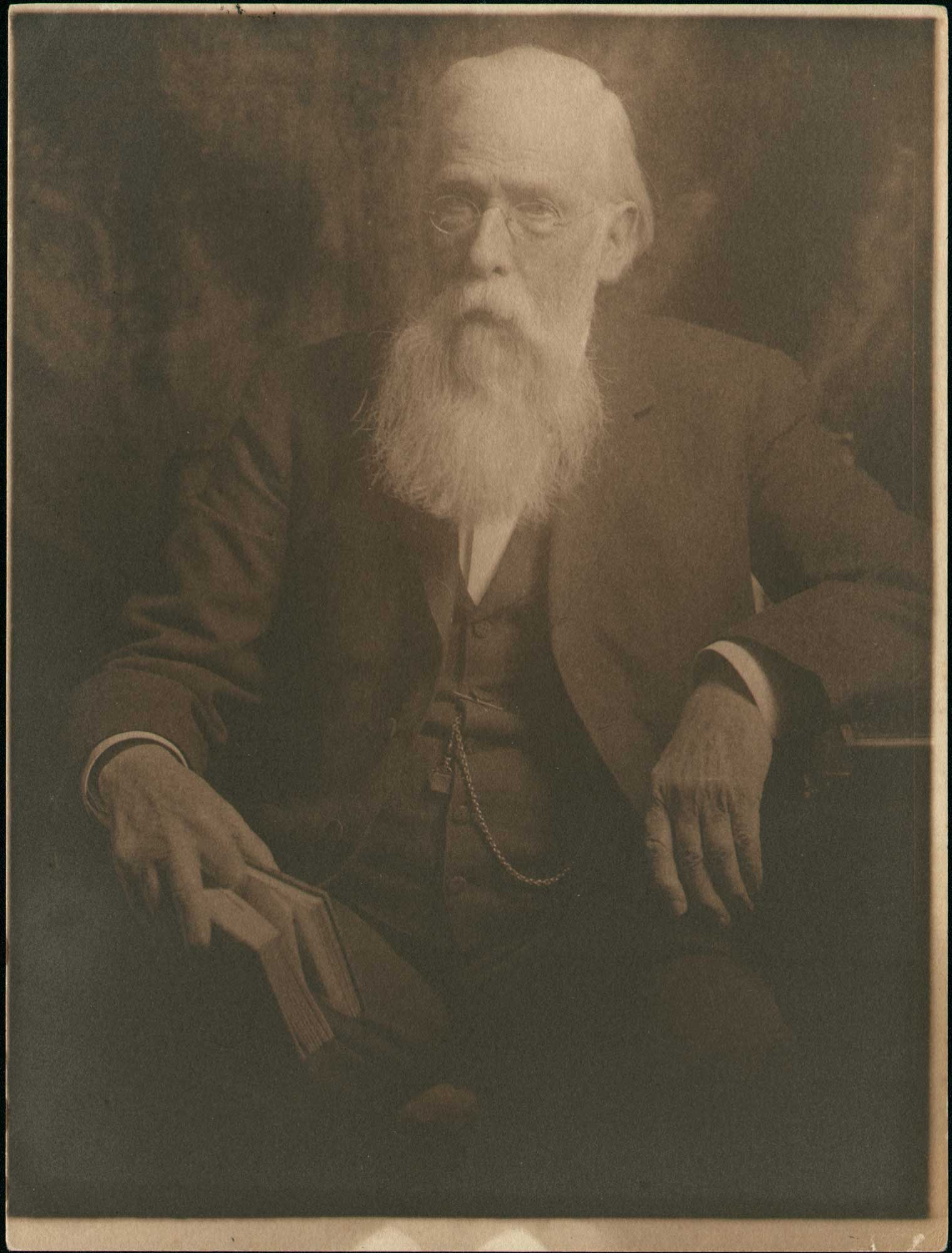
Older Gentleman Holding Book: Dr. Edward Hitchcock Jr.?
Initially, keeping in mind the resemblance, this archive thought this gentleman might be Dr. Edward Hitchcock Jr., 1828-1911, pioneering American physical educator. We later understood this portrait to be Deerfield historian George Sheldon. With guidance and thanks to Ray Radigan, Curator & Assistant Director at Deerfield’s Memorial Hall Museum, this attribution is now questioned. Should you know of the subject’s identity, please contact this archive.
George Sheldon (1818–1916) led one of the first historic preservation societies in the United States. This is a more formal portrait of Sheldon, with trimmed beard, glasses and watch chain. It may have been taken by the Allen sisters around 1895, when his comprehensive two-volume work the History of Deerfield was published. Most photographs, including by the Allen sisters, show Sheldon as sage-like, with a long flowing beard, although a full length study of Sheldon taken by Emma L. Coleman 1853-1942 around 1895 shows Sheldon wearing the same black suit jacket.
From Wikipedia:
He was born in Deerfield, Massachusetts on November 30, 1818. He was educated at Deerfield Academy, and worked as a farmer. In 1844 he married Susan Stewart Stearns of Dummerston, Vermont, and from 1853 to 1857 lived in Chicopee, Massachusetts. In 1857 he was appointed Justice of the Peace at Deerfield and in 1867 was elected as a representative to the General Court, the state legislature of Massachusetts. In 1872 he was elected state senator. His first wife died in 1881. In 1897 he remarried; his second wife was the scientist and historian Jennie Maria Arms.
Sheldon’s interest in history and historical preservation began in 1848, when Deerfield’s Old Indian House (the first home occupied by the Sheldon Family in Deerfield) was demolished despite the objections of local residents. Sheldon, along with others, were able to preserve only the door of the house and some architectural fragments. In 1868, he and others erected a monument to honor the town’s Civil War soldiers. Two years later, they decided to mark the spot where Eunice Williams, the wife of John Williams, was murdered during the 1704 Deerfield Massacre.
From that, the Pocumtuck Valley Memorial Association was born in 1870, and Sheldon would serve as its president until his death at his home in Deerfield on December 23, 1916. The Association founded the Memorial Hall Museum, which houses much of Sheldon’s collection, in 1880. The Association, which took its name from the original inhabitants of Deerfield (and the name of their village, located near the site of the town), was one of the first historical preservation societies in the country. Sheldon was named president of the Association, a post he held to his death. Although he split his time between Deerfield and Boston, he remained an important voice in town issues and a dynamic leader of the Memorial Association. In 1895 he published the History of Deerfield, a comprehensive, two-volume history of the town that included an extensive genealogy of its residents.
Later criticism: During the first seven decades of the English fur trade in the middle Connecticut River valley of Massachusetts, the Pocumtuck, Nonotuck, Sokoki, and other Native American tribal nations were densely documented and actively engaged in intercultural trade, diplomacy, and conflict. Amid the increasing hostilities of the 1670s to the mid-1700s, the valley’s Native people largely folded into the populations of surrounding tribes, and documentation on them diminished. During the 1800s, Deerfield historian George Sheldon depicted this complex history as an Indian vanishing act and refused to acknowledge the presence of living Native descendants.⎯Margaret Bruchac, 2011, writing in the Historical Journal of Massachusetts.


